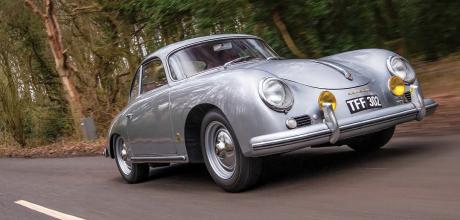1958 Porsche 356 A Coupe
Serial Porsche owner, Jon Stevenson, throws us the keys to his 1958 Porsche 356 A Coupe. And for one Classic Porsche journalist, it’s quite an education...
Words Steve Bennett
Photography Dan Sherwood
1958 356 A COUPE BACKROAD KICKS IN UNRESTORED ICON
TIME MACHINE — Behind the wheel of an unrestored 356 A.
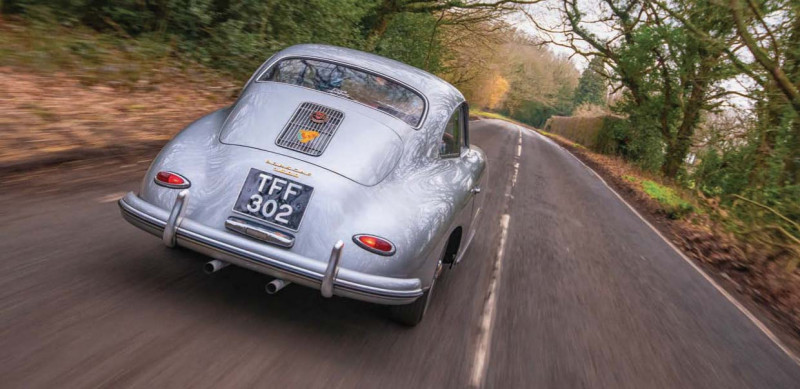
Trundling off to our photo location, it’s hard not to feel a pang of nostalgia. Through narrow village roads, we’re following good friend of Classic Porsche, Jon Stevenson, the owner of a sublime 1958 356 A. Bobbing and weaving, the air-cooled coupe positively scampers along, it’s diminutive dimensions perfectly in tune with our surroundings. The 356 is a teardrop-shaped time capsule, which manages to look both retro and futuristic at the same time. Imagine how this car must have been viewed sixty-five years ago among the period’s rather more austere British four-wheelers. In the here and now, this old Porsche makes modern traffic look bloated and, frankly, quite obscene. None more so than a new, seven-seater Land Rover Defender, as tall as a block of flats and very nearly crushing the 356 on a mini roundabout.
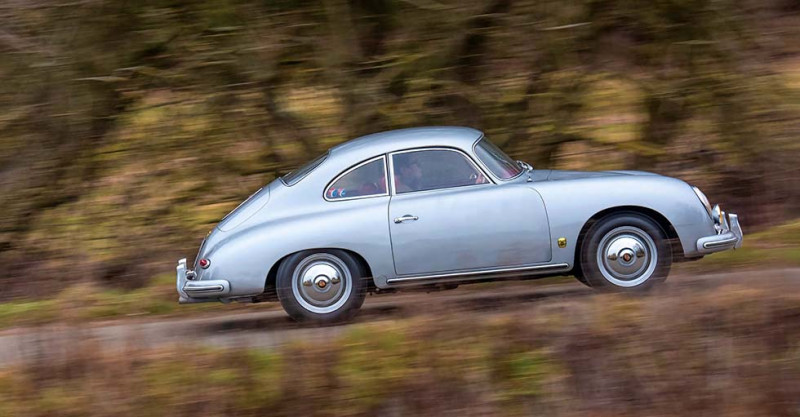
“To be honest,” says Jon, “there’s a time and a place for classic motoring in the twenty-first century. It really isn’t when schools are kicking out on a Tuesday afternoon.” He’s correct, of course, but in order to get to our rendezvous, we have to traverse some of the more populous parts of Hertfordshire. It’s an illustration, perhaps, of why classic car events, from coffee gigs to the Goodwood Breakfast Club and Bicester Scramble, have gained such popularity. Those early morning runs on empty roads replicate times gone by, to which a historic vehicle of just about any description instantly transports you.
I’m keen to be transported. Today, you see, is significant — while I don’t want to make this article all about me, there is something I have to confess to you, dear reader. I am, you see, a 356 virgin. I know, I know. I can’t quite believe it myself, having been a motoring journalist more than thirty years and having written about Porsches for a good many of them. I’ve driven pretty much every variation of 911 I can think of, but there is a glaring 356-shaped hole in my Porsche education. Back to Jon and his 356. Or should that be his 356 and other Porsches? There have been many. And not just the ones that he’s owned, but the ones he’s depicted in bespoke artwork, which we will come to. Oh, and let’s not forget about his Italian dalliances. Confused?
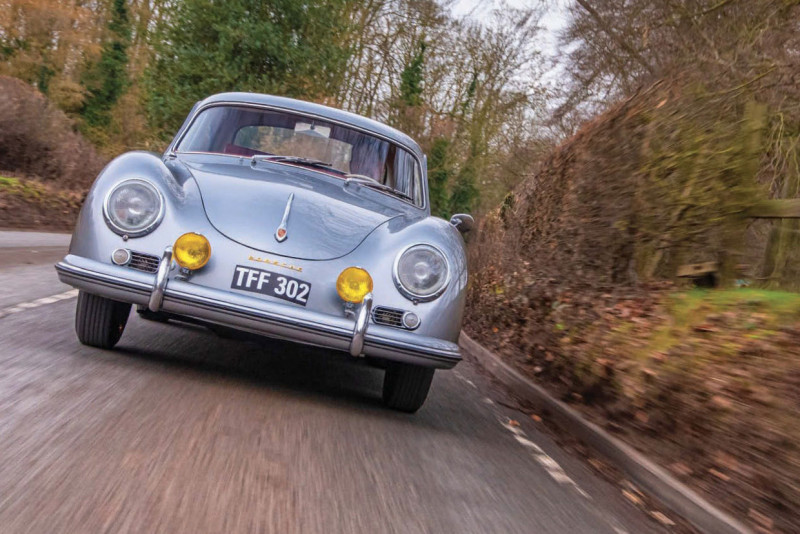
I get Jon’s car trajectory. Italian classics are very alluring, arguably none more so than Alfas and Lancias. Indeed, he owns an 2000 GT Veloce, which is going nowhere. Lancia? A trio of sophisticated Fulvias, including a 1.6 HF ‘Fanalone’ (named after its twin oversized inner headlights). The Fulvia is one of those ‘if you know, you know’ cars. I do know, because I’ve owned one myself. While many stick with the fast (but usually ferrous) world of Italian classics, however, as sure as night follows day, Italian metal can be a gateway to Porsche ownership, if for no other reason than curiosity. It may be a defining, penny-dropping moment. Subtle for some, but for others, the full, cascading, one-armed bandit letting go.
Jon has been the custodian of no fewer than nine Porsches since 2014. Presently, his fast fleet features the 356 A pictured here, as well as two Boxsters (one of the 986 variety, the other a 987). His previous Stuttgart steeds include a short-wheelbase 911 hot rod, a Carrera 3.0, a couple of 928s (one heavily modified), a 993 Carrera, plus plenty more besides.
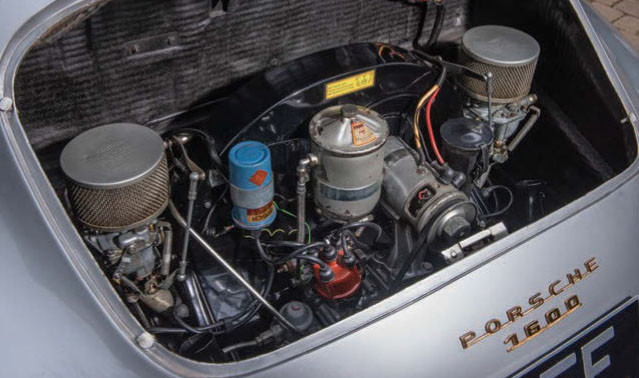
Let’s not get too side-tracked here — the 356 is what turned Jon’s head. “I was at Goodwood and spotted a 356. Obviously, I knew what a 356 was. It was hardly a revelation, but for some reason, I was really taken by the car’s shape. There was something about the simplicity of it.” Well, sometimes things just creep up on you, don’t they? Another day, another setting, and maybe the encounter wouldn’t have struck the same chord.
Regardless, Jon’s obsession with Porsche began that day. He started his quest to buy a 356 in earnest, but it’s fair to say he got a little distracted when the aforementioned Carrera 3.0 presented itself as available for purchase. He then bought a 964 Cabriolet, plus the 911 hot rod project, which he concedes swallowed rather too much of his hard-earned cash and was a car he never really bonded with. Three Porsches in and no 356.
“I wasn’t specifically looking for a 356 A, but when I really started to dig in to the Porsche scene, it became clear the A was where I wanted to be. It’s the final 356 model that can truly be traced back to the original 356 and the Pre-A, certainly in terms of styling.” Indeed, it is — the subsequent 356 B and C can be viewed in much the same way as the jump from pre-1974 911s to the G-series ‘impact bumper’ models.
MISSION POSSIBLE
“Beyond wanting a 356 A, I was fairly open-minded regarding specification. I was happy to buy a project, just as I was content to invest in a Porsche good to go,” he continues. He didn’t restrict himself to the UK market, either. As many of you will attest, thanks to the global reach of the internet, finding the right car is now just a click away. “I was looking for cars in many of the world’s dry climate locations. I had an A inspected in Australia, for example. I didn’t buy the car, but the seller also offered up an early 911 Turbo, which previously belonged Formula One World Champion, Alan Jones. I passed on the car, only for it to be bought by Magnus Walker.
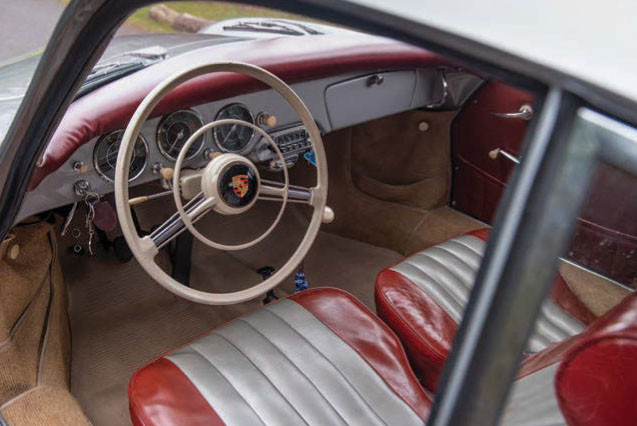
The seller only wanted fifty grand. Finished in metallic brown, it’s now a well-known car. The one that got away, I guess.” Ah, what could have been.
With this 1958 356 A 1600 of US origin, the stars aligned. The car was brought into the UK by purveyor of fine and interesting Porsches, Edmund Harris, in 2000. In the toss-up between ‘project’ and ‘good to go,’ it is very much the latter. Given the short-wheelbase 911 hot rod project was still ongoing, the 356’s ‘up and running’ status was very much a good thing.
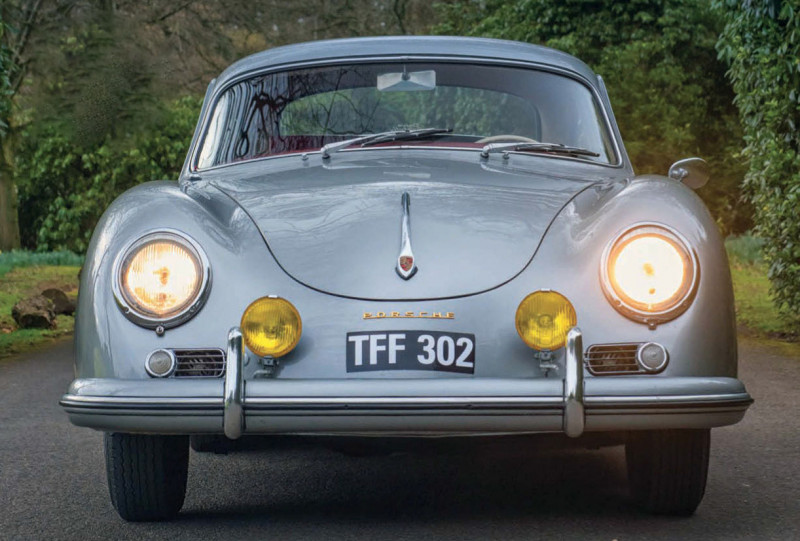
“I bought it from PR Services. As anyone with even a passing interest in 356s will know, this company is one of the UK’s foremost 356 specialists.” What was it about this particular 356 encouraging him to pull the trigger? “It’s very original,” Jon tells me. “Aside from minor paintwork applied in 1999 by PS Automobile in Germany, the car’s bodywork hasn’t been restored, which is very unusual for a 356 of this age. All I’ve had to do is drive and maintain the car. There wasn’t any real history from its time in America, but the overall condition of the car spoke for itself.”
It certainly does. The original six-volt electrics are still at play, the mats are original and the underside exhibits the correct factory finish (in the form of a thin layer of underseal), which hides nothing. “I took a door card off the other day. It’s clear this car has never been touched.” Another name familiar to British 356 aficionados is engine builder, Barry Curtis. Jon’s 356 features one of Barry’s breathed-on flat-fours, putting out close to 85bhp. This might not sound much, but it’s sprightly enough in a car weighing only 850kg. Oh, and let’s not forget, the 356’s super-slippery 0.30 drag coefficient, which helped it crack the 100mph barrier.
Jon is fortunate to have independent classic Porsche specialist, Export 56, not far from where he lives. You’ll have read about the company across previous pages. “I probably spend too much time in the company’s workshop,” Jon laughs. “Then again, it’s always a treat to drop in, and company founder, Mick Pacey, has become a good friend. There’s no doubting he and his team know all generations of 356 inside out.” And now it’s time for me to get acquainted — Jon hands me his car’s delicately small ignition key. Before I complete my Porsche driving education test, however, it’s worth a quick recap regarding where the A-generation fits into the 356 timeline, if only to acclimatise myself.
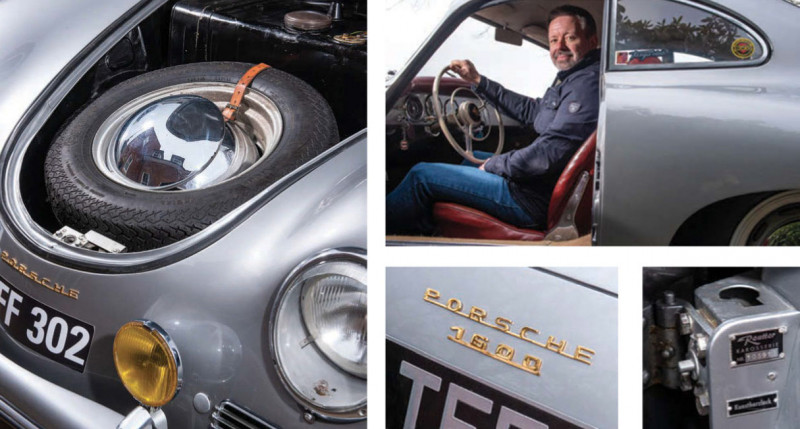
The first Stuttgart-built 356s are colloquially known as the Pre-A models, for the obvious reason they pre-date the 356 A. Built from early 1950 until Sept 1955, these earlier 356s all carry features making identification easy. Most obvious is the windscreen — until mid-1952, all 356s made use of a two-piece windscreen, with a rubber dividing seal in the centre. Subsequently, a single-piece screen was fitted, albeit with a distinct fold line down the middle. Pre-A 356s can also be spotted by the way the sill panels curve under the car, while at the rear, tiny rectangular taillights do their best to provide illumination.
NEXT GENERATION
The 356 A arrived in 1955 and is easily defined by its more panoramic, curved windscreen and the absence of quarter lights in the doors. The sill panels were flat, with a ‘deco trim’ rubbing strip. The rear lights took on what’s known as the ‘beehive’ look. Jon’s 356 A is actually a Type 2 variant (introduced in 1957), which displays further detail changes, including relocated bumpers and fifteen-inch wheels with flatter hub caps and Porsche-crested centre caps. Later 356 A Type 2 models feature exhaust tailpipes exiting rather stylishly through the rear bumper overriders.
In terms of shared heritage of engine and transmission, it’s often seen as fair game to point the Volkswagen finger at Pre-A 356s, but this absolutely isn’t the case with the 356 A. Sure, they make use of aircooled engines with horizontally opposed cylinders, but they share no major components and, it has to be said, very few minor parts.
The 356 A models were available with five different engine options, ranging from the basic 44bhp 1300 to the exotic quad-cam 110bhp Carrera engine, first seen in the legendary 550 Spyder, complete with its bevel-drive overhead cams and twin-plug ignition. Definitely no Beetle bits in that, thank you very much. Bang in the middle (and by far the most popular), were the two 1600 units: the 60bhp ‘Normal’ and the 75bhp ‘Super’ variants.
Sticking with the VW connection for a moment, it’s a similar story for the chassis. The front suspension and steering system are close to that of the Beetle, with transverse, multi-leaf torsion bars and a pair of trailing arms on each side. Steering is via a steering box, while the rear suspension comprises swing axles with torsion bars and hydraulic dampers. Conceptually, this setup might have Beetle connotations, but there is no parts compatibility worth speaking of.
Following the 356 A came the 356 B in 1961 and the 356 C in 1963. Both later models featured ‘upright’ headlights, plus a larger rear window and twin cooling intake grilles. The 1600 engine was developed to 90bhp, while the final GS-labelled four-cam was stretched to two litres of displacement and 130bhp. This engine continued production well into 1964, alongside the then new 911.
That’s a short history of the 356’s Stuttgart years. Class dismissed — I’ve got some driving to do. Patina is an overused word in this business. Clearly, Jon’s 356 A has it, thanks to being largely unrestored. More than this, though, is the unmistakable classic Porsche (or otherwise) whiff of leather, combustion and burned dust. It’s only original once, as they say.
The cabin is a tight, but not uncomfortable fit, even with my thirty-four-inch pins. Of course, the pedals sprout from the floor, while the big steering wheel sits upright in my lap. Safety belts are optional. Turn the tiny key in the ignition and the 1.6-litre, pushrod, flat-four churns into life. It’s got character, alright.
Getting underway, my first impression is that everything is, well, delicate. This isn’t to say the 356 isn’t robust (we absolutely know a Porsche is just that), but it’s more of a feel transmitted through the controls. The clutch is light and spring-loaded. The slender, curved gear lever also has a distinct and light spring to its action before the lever is released and the next gear is located. It takes just a nudge to cross the gate fore and aft.
The steering is a touch vague (as you might expect from any vehicle with a steering box), but once the slack is taken up, it feels pleasantly loose, but without feeling sloppy, which is to say the car drifts along on its skinny tyres and requires just a gentle turn of the steering wheel to get settled into a corner. The mantra is very much ‘slow in, fast out’. Oh, and no sudden movements. Again, there is delicate feel to enjoy, partly thanks to the weight at the rear leaving the front wheels to skim the road surface.
STOPPING POWER
The only warning Jon gives before I head off is to “watch the brakes”. Yes, they’re drums, but not as scary as he intimated. Still, forewarned is forearmed, and the shove required is at odds with the other vital controls.
The stock 75bhp peaks at 5,000rpm, with a modest 86lb-ft at 3,700rpm. Jon’s car’s Barry Curtis flat-four chucks out a bit more. Typically, it’s torque you feel on the road. There’s a low, solid thrum from behind. The engine is no high-revving powerhouse, and it gives the impression 4,000rpm is the performance and power sweet spot, no matter what the redline might suggest.
You drive within the powerband, making the most of what’s there, gently cajoling the weighty rear into a corner, so as not to upset the swing of the axle. Hold it there, until the road starts to unwind, then apply the power. Back to the Beetle bits. In rather clichéd fashion, I suggested to Jon I rather expected the 356 to drive like a Bug. He wasn’t entirely surprised, and there are similarities, but the Porsche is a whole lot more sophisticated in the way it feels. I guess it should do, too.
The 356 also feels sophisticated when compared to its 1950s and 1960s contemporaries. I’m reminded of when legendary Motorsport journalist, Denis Jenkinson, used a succession of 356s (from Pre-A to C) to travel the length and breadth of Europe to report on Grand Prix and endurance events, often at high-speed. He was always full of praise for the 356’s rapid pace and cruising abilities. This car does feel unburstable and remarkably quiet at speed, a result of its slippery aero shape.
Back at Jon’s house, I hand the keys back. It’s been an education, for sure. I don’t mind admitting I’m ashamed of the fact I haven’t engineered a 356 drive before now, whether in a Pre-A, A, B or C. The air-cooled Porsche joins the two water-cooled Boxsters on his driveway. Quite a collection. Worth a picture, or indeed a painting. Ah, yes, the painting. Such is Jon’s passion for Porsche, following a career in corporate finance, he’s downed spreadsheets and picked up his brushes, creating impressive large-scale canvases depicting classic Porsche road and race cars. Well, there is something about the way 911 curvature catches the light and seemingly absorbs reflections, after all. It’s something Jon’s work in acrylics captures beautifully.
An increasing number of Porsche owners like his paintings — he’s sold many and has more than a few commissions on the go. Just as we leave him, he’s prepping for an exhibition at sports car sales specialist, Hexagon Classics. “The shape of the 356 is what really inspires me. Other Porsches will come and go, but my 356 is definitely a keeper.” We can see why.
FOLLOWING A CAREER IN CORPORATE FINANCE, HE’S DOWNED SPREADSHEETS AND PICKED UP HIS BRUSHES
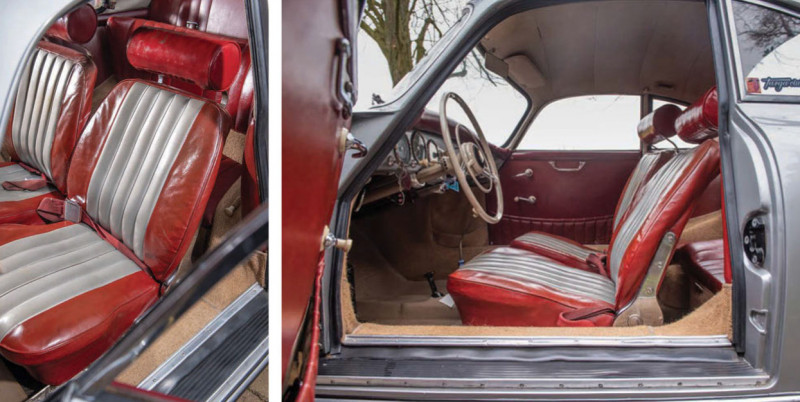
Above The car’s unrestored state means Jon isn’t afraid to rack up mileage, although he understandably prefers to head out first thing in the morning, when today’s modern, imposing traffic is at its bare minimum.
Above Since embracing Porsche ownership, Jon has been the proud custodian of many air- and water-cooled Stuttgart-crested sports cars, but maintains this 356 is the one he’ll never part with.
Below Flat-four was rebuilt and modified by Barry Curtis, who released an extra ten ponies in the process.
THE CAR DRIFTS ALONG ON ITS SKINNY TYRES AND REQUIRES JUST A GENTLE TURN OF THE WHEEL TO GET SETTLED INTO A CORNER
Above When Jon was on the hunt for a 345, he on passed on the now famous metallic brown 911 Turbo (930) subsequently bought by Urban Outlaw, Magnus Walker.
Above and below From nose to tail, the car is patinatastic, with a body remaining unrestored, save for minor paintwork carried out in France many moons ago.
THE CAR WAS BROUGHT INTO THE UK BY PURVEYOR OF FINE AND INTERESTING PORSCHES, EDMUND HARRIS, IN 2000
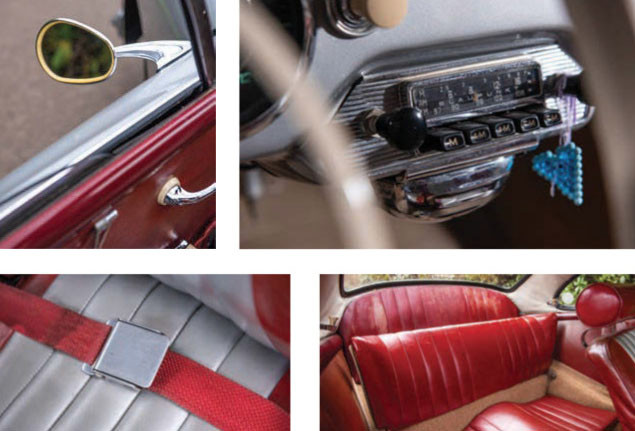
Above Spotting a 356 in the car park at Goodwood kick-started Jon’s obsession with Porsche, which led to him quitting his successful career and becoming an artist painting canvases of Stuttgart’s finest sports cars.


